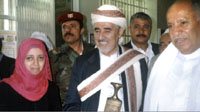
Maysa Ali: Disabled but talentedDrawing is the only thing that makes me feel the value of life [Archives:2005/841/Culture]
May 12 2005
 |
Taiz Bureau
A flower-like girl with a distinct drawing talent, rising over the barriers of her handicap to display her rare skill in the art of drawing. An onlooker stands surprised at her magnificant work, wondering how 14-year-old, Maysa Abdullah could translate her feelings and emotions into colors and shapes. With an adolescent face shining with innocence, her drawings compensate for her disability of being unable to talk, as a picture is worth a thousand words, and hers was worth a million.
We met her at her show in al-Sa'eed Cultural Foundation and communicated with her through one of her relatives.
Q: Could you introduce yourself?
A: My full name is Maysa Ali Abdullah No'man. I am 14 years old and am currently studying at the Special Needs Institute.
Q: When did you start practicing portraying?
A: This God given gift began when I was six. I used to draw spontaneous shapes to express something through lines and colors.
Q: When do you feel more inclined to draw? Is it when you are happy or sad?
A: It makes no difference. There is no specific time for drawing. I can draw at any time, both sad and glad. Drawing is the only nice thing that I can't be irritated with as it makes me realise my existence and value in life.
Egyptian environment influence:
Q: Your paintings show that you are very much influenced by the Egyptian environment, countryside and Egyptian rural women. What is the reason behind this tendency and why do you not derive your drawings from Yemeni environments and countrysides?
A: That is true. This is because I spend most of my time at home watching TV and I mostly watch Egyptian serials. It is my world and the way in which I see others. I scarcely go outside because of my special condition. However, when I do get glimpses of natural scenes on the way from Taiz to Sana'a; valleys, terraces, houses lying on mountain peaks etc., I try to transform them onto paper.
Q: Why don't you travel to your parent's village to see the Yemeni countryside and create drawings that depict the local surroundings?
A: I never did that. My parents don't want me to go there because villagers still look down on people with special needs.
Q: Do you receive support and encouragement from your family and relatives since your early trials at drawing?
A: I was tremendously encouraged by the closest people around me, which are my parents. They opened the door of hope and love of life to me. They taught me to live without despair. All my achievements are in gratitude to them.
Q: How did you get the idea of organizing this show and is this the first show?
A: The idea of the show was inspired to me by Abdullah Abdu Sa'eed whom I would call my spiritual father. He helped me and boosted my talent by introducing my drawings to al-Sa'eed Cultural Foundation to take part in the exhibition. Concerning previous participations, I contributed under the Sina Girls School to an exhibition at the Cultural Center.
Q: Why are most paintings drawn with pencil and are in black and white. Does this signify something?
A: I used to draw with a pencil. Using color requires concentration. The drawings you mean, however, are my early attempts. There are other colored paintings.
Q: Do you intend to refine your talent with studies and majoring in the art of drawing?
A: Why not, with God's will. If I get support from organizations or individuals, I would embrace this idea. Study needs expenses.
Q: Have you sold some of your works?
A: Yes. Three of them were purchased by the Taiz Governor Mohammed Abdullah al-Hajri. Other paintings were sold by a businessman while some were sold to people I don't know.
Q: Do you suggest prices or leave do you leave it up to the purchasers?
A: I don't do that. People at the Foundation give each drawing a price.
Q: What did Dr. Tariq Swaidan tell you when he visited the Exhibition and saw your drawings?
A: I am proud of his visit to my show. He wrote the following in the guest book: “Today, I met a rare lass. A creative young lady whom I will cite as an example for others in terms of volume, diligence and determination. I congratulate my daughter Maysa Ali Abdullah No'aman on her persisting to be creative in life and challenge disability. I ask Allah to grant her more perseverance, arts and creativity. To her goes my appreciation and prayer.” Dr. Tariq Swaidan. April 27, 2005.
Q: Do you have any last comments?
A: I address the officials of the Ministry of Culture to take care of the creative people and support the gifted especially those with special needs. This category includes great and various capabilities. To take care of them means to recognize their value. I also appeal to journalists to replace the hurting labels such as dumb, deaf, blind etc. with the phrase “special needs.”
——
[archive-e:841-v:13-y:2005-d:2005-05-12-p:culture]


